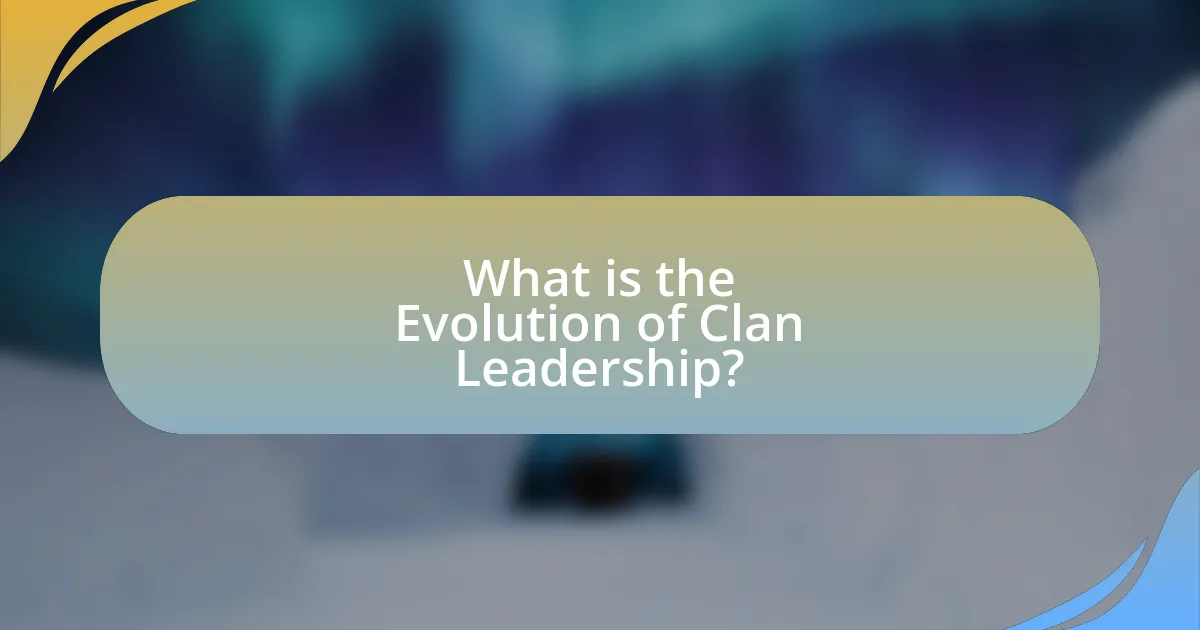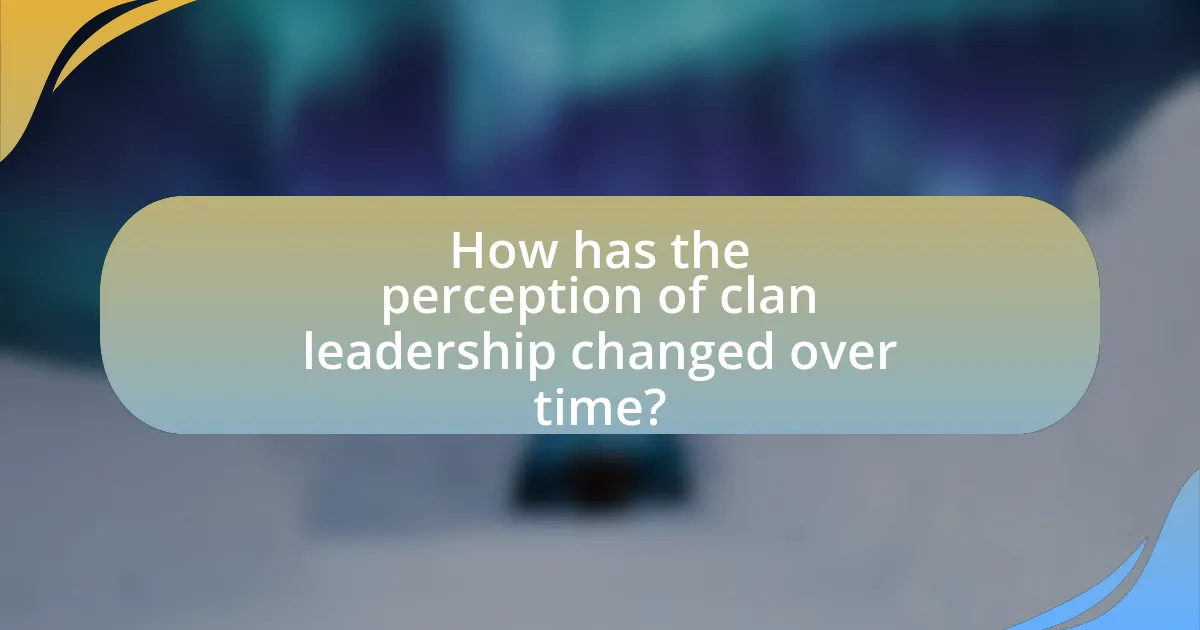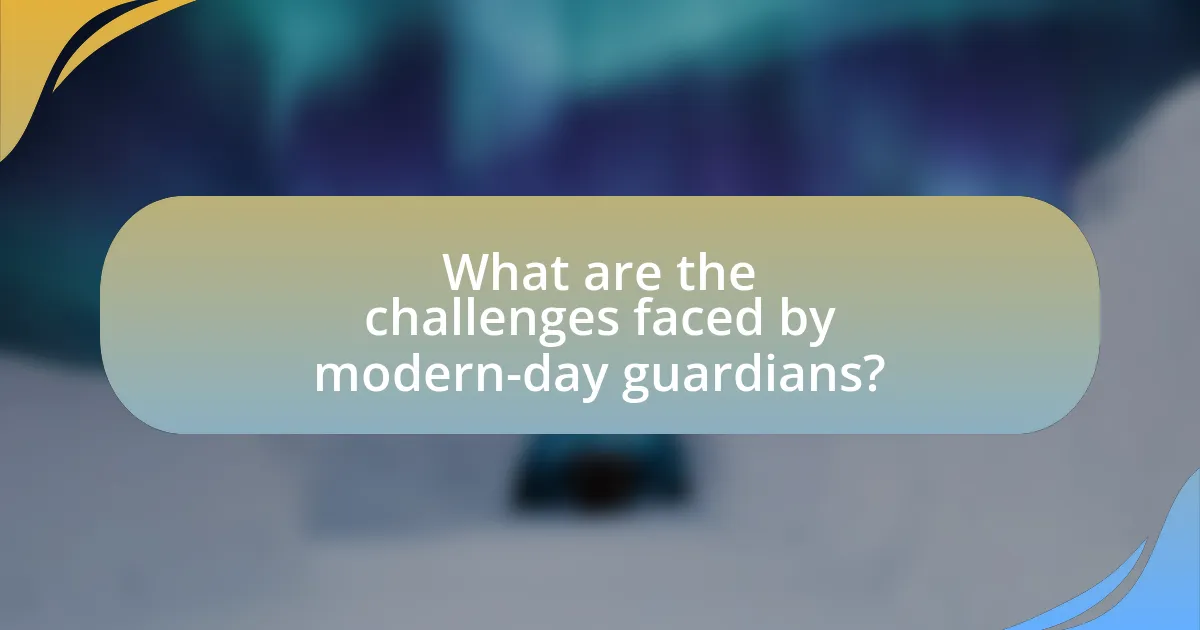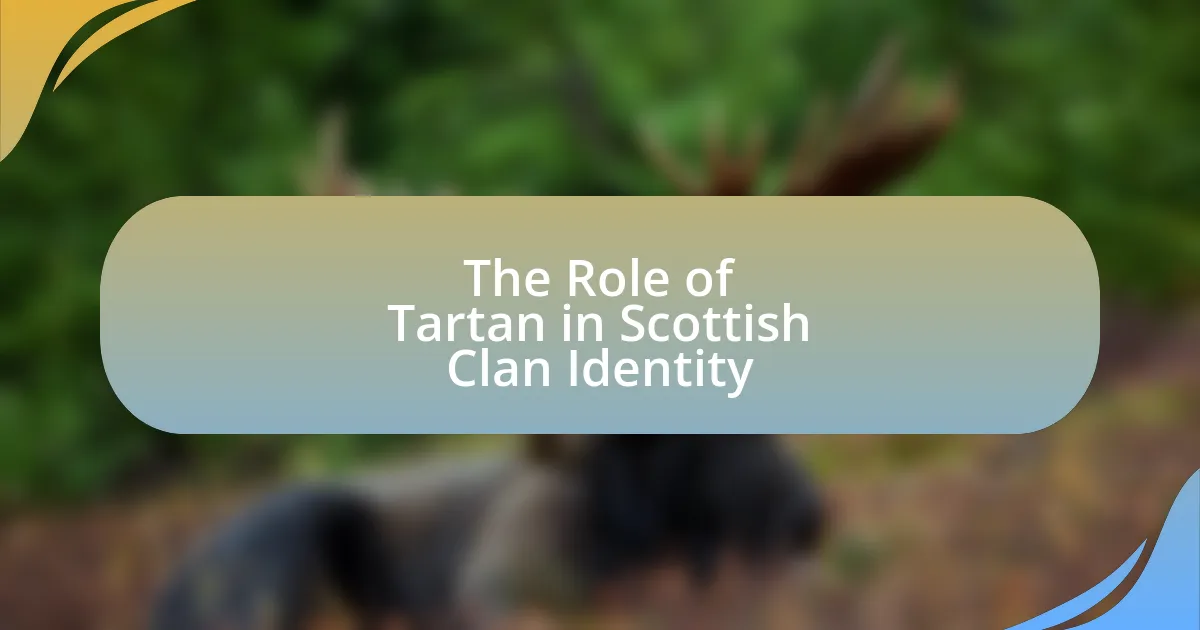The article examines the evolution of clan leadership, tracing the transition from traditional chieftains to modern-day guardians. It outlines the historical context of clan leadership, detailing the roles and decision-making processes of early chieftains, and how societal changes influenced the shift towards guardianship. Key factors such as social evolution, legal frameworks, and economic changes are discussed, highlighting the characteristics and responsibilities of contemporary guardians. The article also addresses the challenges faced by modern leaders in maintaining clan unity and cultural heritage while adapting to contemporary societal expectations.

What is the Evolution of Clan Leadership?
The evolution of clan leadership has transitioned from traditional chieftains to modern-day guardians, reflecting changes in societal structures and governance. Historically, clan leaders, often referred to as chieftains, held power based on lineage, military prowess, and tribal loyalty, governing their clans through a combination of kinship ties and communal consensus. As societies evolved, particularly with the advent of centralized states and legal systems, the role of clan leaders shifted towards more symbolic and cultural functions, emphasizing community cohesion and heritage preservation. In contemporary contexts, modern-day guardians often focus on advocacy, cultural education, and community development, adapting to the needs of their clans while navigating broader societal changes. This transformation illustrates the dynamic nature of leadership roles in response to historical, social, and political developments.
How did clan leadership begin in ancient societies?
Clan leadership in ancient societies began as a response to the need for organization and protection within groups of people. Early human communities, often composed of extended families or tribes, required a figure to coordinate resources, manage conflicts, and lead during times of crisis. This role typically fell to individuals who demonstrated strength, wisdom, or lineage, establishing a hierarchy that was often hereditary. Historical evidence from various cultures, such as the tribal systems of Native Americans and the chieftaincy in early Celtic societies, illustrates that leaders were often chosen based on their ability to provide for and protect their clan, thereby solidifying their authority and influence within the group.
What roles did chieftains play in early clans?
Chieftains in early clans served as the primary leaders and decision-makers, responsible for the governance, protection, and organization of their communities. They held authority over clan members, managed resources, and led in times of conflict, ensuring the clan’s survival and cohesion. Historical evidence indicates that chieftains often acted as mediators in disputes, maintained alliances with other clans, and upheld cultural traditions, which were vital for social stability and identity within the clan structure.
How were decisions made within these early clans?
Decisions within early clans were typically made through a consensus-based approach, where leaders or chieftains would consult with elders and influential members of the clan. This method ensured that various perspectives were considered, fostering unity and collective agreement on important matters such as resource allocation, conflict resolution, and social norms. Historical evidence indicates that this collaborative decision-making process was essential for maintaining social cohesion and stability within the clan, as it allowed for shared responsibility and accountability among members.
What factors influenced the transition from chieftains to modern guardians?
The transition from chieftains to modern guardians was influenced by factors such as social evolution, legal frameworks, and economic changes. Social evolution led to the emergence of more complex societal structures, necessitating a shift from traditional chieftain roles to guardians who could navigate modern governance. Legal frameworks, including the establishment of formal laws and regulations, replaced the informal authority of chieftains, requiring guardians to operate within a structured legal context. Economic changes, particularly the move from agrarian economies to industrial and service-oriented economies, demanded new forms of leadership that could manage diverse community needs and resources effectively. These factors collectively facilitated the evolution of leadership from chieftains to modern guardians, reflecting the changing dynamics of society.
How did social structures impact clan leadership evolution?
Social structures significantly influenced the evolution of clan leadership by determining the hierarchy, roles, and responsibilities within clans. As societies transitioned from nomadic to settled agricultural lifestyles, social stratification emerged, leading to more defined leadership roles. For instance, in many early clans, leaders were often chosen based on kinship ties or demonstrated prowess in battle, reflecting the clan’s social organization. Historical evidence shows that as clans grew in size and complexity, leadership became more institutionalized, with roles such as chieftains or councils of elders emerging to manage resources and resolve conflicts. This evolution was further shaped by external factors, such as trade and warfare, which necessitated more organized leadership structures to navigate these challenges effectively.
What external influences shaped the roles of clan leaders over time?
External influences that shaped the roles of clan leaders over time include political changes, economic shifts, and cultural interactions. Political changes, such as the rise and fall of empires, often redefined the authority and responsibilities of clan leaders, as seen during the expansion of the Roman Empire, which integrated various tribes and altered their leadership structures. Economic shifts, particularly the transition from subsistence agriculture to trade-based economies, required clan leaders to adapt their roles to manage resources and negotiate with external entities, as evidenced by the emergence of trade routes in the Middle Ages. Cultural interactions, including the spread of religions and ideologies, influenced clan leaders to adopt new governance styles and social norms, exemplified by the impact of Islam on tribal leadership in the Arabian Peninsula. These external factors collectively transformed the functions and significance of clan leaders throughout history.
What are the key characteristics of modern-day guardians?
Modern-day guardians are characterized by their commitment to community welfare, adaptability to change, and emphasis on inclusivity. These guardians prioritize the well-being of their communities, often engaging in social initiatives and support systems that address contemporary issues such as education, health, and environmental sustainability. Their adaptability is evident in their ability to navigate the complexities of modern society, utilizing technology and innovative practices to enhance their leadership. Furthermore, modern-day guardians foster inclusivity by ensuring diverse voices are heard and represented, reflecting a broader understanding of community dynamics. This shift from traditional chieftain roles to guardianship highlights a more collaborative and responsive approach to leadership in today’s world.
How do modern guardians differ from traditional chieftains?
Modern guardians differ from traditional chieftains primarily in their approach to leadership and community engagement. While traditional chieftains often held hereditary power and made decisions based on lineage and tribal customs, modern guardians typically emphasize collaborative governance and inclusivity, often incorporating democratic principles. For instance, modern guardians may utilize community meetings and digital platforms to gather input from diverse members, contrasting with the unilateral decision-making common among chieftains. This shift reflects broader societal changes towards egalitarianism and participatory leadership, demonstrating a move away from rigid hierarchies towards more flexible, community-oriented structures.
What responsibilities do modern guardians hold within their communities?
Modern guardians hold several key responsibilities within their communities, primarily focused on safeguarding the well-being and development of their members. These responsibilities include providing mentorship, ensuring safety, fostering community engagement, and promoting cultural heritage. For instance, guardians often act as role models, guiding younger generations through challenges and instilling values. Additionally, they play a crucial role in conflict resolution, mediating disputes to maintain harmony. Research indicates that communities with active guardians experience lower crime rates and higher levels of civic participation, demonstrating the positive impact of their involvement.

How has the perception of clan leadership changed over time?
The perception of clan leadership has evolved from viewing chieftains as absolute rulers to recognizing modern-day leaders as collaborative guardians. Historically, clan leaders were seen as authoritative figures wielding significant power and control over their members, often justified by lineage and tradition. In contemporary contexts, leadership is increasingly characterized by inclusivity, shared decision-making, and a focus on community welfare, reflecting broader societal shifts towards democratic values and collective responsibility. This transformation is evident in various cultures where traditional leadership roles are adapting to incorporate modern governance principles, emphasizing the importance of consensus and community engagement over unilateral authority.
What historical events marked significant changes in clan leadership?
Significant changes in clan leadership were marked by events such as the Norman Conquest of England in 1066, which led to the restructuring of power dynamics among clans and the establishment of feudalism. This event diminished the autonomy of many local clans as they were integrated into a hierarchical system under the control of Norman lords. Another pivotal event was the Highland Clearances in the 18th and 19th centuries, which resulted in the displacement of many Scottish clans and the decline of traditional clan structures. Additionally, the introduction of legal reforms in the 19th century, such as the abolition of hereditary titles, further transformed clan leadership by shifting power from hereditary chiefs to elected representatives. These events collectively illustrate the evolution of clan leadership from traditional systems to more modern governance structures.
How did colonization affect traditional clan structures?
Colonization significantly disrupted traditional clan structures by undermining their authority and altering social dynamics. Colonial powers often imposed new governance systems that marginalized clan leaders, leading to a loss of traditional power and influence. For instance, in many African regions, colonial administrations replaced indigenous governance with centralized bureaucracies, which diminished the role of chieftains and clan elders. This shift resulted in the erosion of cultural practices and communal decision-making processes that had been integral to clan identity. Historical evidence shows that in places like Kenya and Nigeria, colonial rule not only disrupted clan hierarchies but also fostered divisions among clans, exacerbating conflicts and weakening social cohesion.
What role did wars and conflicts play in reshaping clan leadership?
Wars and conflicts significantly reshaped clan leadership by altering power dynamics and necessitating new forms of governance. During periods of warfare, clans often experienced shifts in leadership as military success or failure could elevate or diminish a leader’s status. For instance, in many tribal societies, leaders who demonstrated strategic prowess in battle gained legitimacy and authority, while those who failed to protect their clan faced challenges to their leadership. Historical examples include the rise of war chiefs in Native American tribes, where leaders were often chosen based on their ability to lead in conflicts, thus reinforcing the idea that effective military leadership was crucial for maintaining clan cohesion and influence. Additionally, conflicts often led to alliances and rivalries that further transformed leadership structures, as clans adapted to changing circumstances to ensure survival and dominance.
How do cultural shifts impact the role of clan leaders today?
Cultural shifts significantly impact the role of clan leaders today by redefining their authority and responsibilities within their communities. As societies become more globalized and interconnected, traditional clan leaders are increasingly expected to adapt to modern values such as democracy, gender equality, and individual rights. For instance, in many regions, clan leaders are now engaging in community development initiatives that prioritize education and health, reflecting a shift from purely tribal governance to a more holistic approach to leadership that addresses contemporary social issues. This evolution is evidenced by the increasing involvement of clan leaders in local governance structures and their collaboration with governmental and non-governmental organizations to promote sustainable development, thereby enhancing their relevance in today’s society.
What modern values influence the leadership styles of guardians?
Modern values such as inclusivity, collaboration, and ethical responsibility significantly influence the leadership styles of guardians. These values promote a leadership approach that prioritizes community engagement and shared decision-making, reflecting a shift from traditional authoritative models. For instance, guardians often emphasize transparency and accountability, aligning with contemporary expectations for leaders to act with integrity and foster trust within their communities. This evolution is evident in organizations that adopt participatory leadership practices, which have been shown to enhance team cohesion and morale, ultimately leading to more effective governance.
How do contemporary issues affect the responsibilities of clan leaders?
Contemporary issues significantly expand the responsibilities of clan leaders by requiring them to address social, economic, and environmental challenges within their communities. For instance, clan leaders now often engage in conflict resolution related to land disputes exacerbated by urbanization and climate change, which can lead to resource scarcity. Additionally, they are increasingly involved in promoting education and health initiatives to combat rising poverty levels and improve community well-being. This shift reflects a broader expectation for clan leaders to act as advocates for their members, navigating modern governance structures while preserving traditional values. The necessity for clan leaders to adapt to these contemporary issues is evident in their active participation in local governance and community development projects, demonstrating their evolving role as guardians of both cultural heritage and social progress.

What are the challenges faced by modern-day guardians?
Modern-day guardians face several challenges, including balancing traditional responsibilities with contemporary societal expectations. These guardians often struggle with the pressure to maintain cultural heritage while adapting to modern legal and social frameworks. Additionally, they encounter difficulties in resource management, as many guardians must navigate financial constraints and limited access to support systems. The rise of digital communication also presents challenges in maintaining community cohesion and engagement, as guardians must find effective ways to connect with younger generations who may be more digitally oriented.
What obstacles do guardians encounter in maintaining clan unity?
Guardians encounter several obstacles in maintaining clan unity, primarily including generational divides, differing values, and external societal pressures. Generational divides often lead to conflicts in perspectives and priorities, as younger members may prioritize modern values over traditional practices. Differing values within the clan can create factions, undermining collective identity and cohesion. Additionally, external societal pressures, such as economic challenges and cultural assimilation, can further strain relationships among clan members, making it difficult for guardians to foster a unified community. These factors collectively hinder the guardians’ ability to uphold clan unity effectively.
How do economic factors challenge clan leadership today?
Economic factors challenge clan leadership today by creating disparities in wealth and resources that undermine traditional authority structures. As global markets evolve, clans face competition from external economic forces, leading to a decline in their influence and relevance. For instance, the rise of urbanization and industrialization has shifted economic opportunities away from rural clan-based systems, diminishing their traditional roles. Additionally, economic inequality within clans can lead to internal conflicts, as wealthier members may seek to assert dominance over poorer members, fracturing unity. This dynamic is evident in various regions where clans struggle to maintain cohesion amidst changing economic landscapes, highlighting the significant impact of economic factors on their leadership.
What role does technology play in modern clan leadership challenges?
Technology significantly influences modern clan leadership challenges by facilitating communication, decision-making, and resource management. Digital platforms enable clan leaders to connect with members across vast distances, fostering collaboration and unity. For instance, social media tools allow for real-time updates and engagement, which is crucial for maintaining clan cohesion. Additionally, data analytics can inform leaders about member preferences and behaviors, enhancing strategic planning. A study by the Pew Research Center indicates that 72% of adults use social media, highlighting its potential impact on community dynamics. Thus, technology serves as a vital tool for modern clan leaders to navigate challenges effectively.
How can modern guardians effectively lead their clans?
Modern guardians can effectively lead their clans by fostering strong communication, promoting inclusivity, and leveraging technology for organization and decision-making. Effective communication ensures that all clan members are informed and engaged, which builds trust and unity. Promoting inclusivity allows for diverse perspectives, enhancing problem-solving and innovation within the clan. Utilizing technology, such as social media and collaborative platforms, streamlines coordination and facilitates real-time updates, making leadership more efficient. These strategies are supported by studies indicating that inclusive leadership leads to higher team performance and satisfaction, as seen in research published in the Journal of Leadership Studies.
What strategies can guardians employ to foster community engagement?
Guardians can foster community engagement by implementing inclusive communication strategies, organizing community events, and promoting volunteer opportunities. Inclusive communication ensures that all community members feel heard and valued, which can be achieved through regular meetings, surveys, and feedback mechanisms. Organizing community events, such as festivals or workshops, encourages participation and strengthens social bonds among residents. Promoting volunteer opportunities allows community members to contribute actively, fostering a sense of ownership and responsibility towards their environment. These strategies are supported by research indicating that active participation in community activities enhances social cohesion and trust, which are essential for effective community engagement.
How can guardians balance tradition with modernity in their leadership?
Guardians can balance tradition with modernity in their leadership by integrating traditional values into contemporary practices. This approach allows them to honor their cultural heritage while adapting to current societal needs. For instance, guardians can implement community decision-making processes rooted in traditional customs while utilizing modern technology for communication and organization. Research shows that organizations that blend traditional leadership styles with modern management techniques often experience increased community engagement and satisfaction, as seen in studies conducted by the Harvard Business Review, which highlight the effectiveness of hybrid leadership models in diverse cultural contexts.
What best practices can be adopted by modern clan leaders?
Modern clan leaders should adopt inclusive decision-making, effective communication, and community engagement as best practices. Inclusive decision-making fosters collaboration and ensures that all members feel valued, which can enhance loyalty and commitment. Effective communication is crucial for transparency and trust, allowing leaders to convey their vision and gather feedback. Community engagement strengthens ties among members and promotes a sense of belonging, which is essential for the clan’s cohesion and resilience. These practices are supported by research indicating that participatory leadership styles lead to higher satisfaction and performance within groups.
How can guardians ensure the preservation of cultural heritage?
Guardians can ensure the preservation of cultural heritage by actively engaging in documentation, education, and community involvement. By documenting traditions, languages, and practices, guardians create a record that can be passed down through generations, which is essential for maintaining cultural identity. Education initiatives, such as workshops and cultural programs, foster awareness and appreciation among younger generations, ensuring that cultural practices are not lost. Furthermore, involving the community in preservation efforts strengthens the collective commitment to safeguarding heritage, as seen in various successful cultural preservation projects worldwide, such as the UNESCO World Heritage Sites program, which emphasizes local participation in heritage management.
What methods can be used to enhance communication within clans?
To enhance communication within clans, implementing regular meetings and utilizing digital communication platforms are effective methods. Regular meetings foster face-to-face interaction, allowing members to discuss issues, share ideas, and strengthen relationships. Digital platforms, such as messaging apps and social media groups, facilitate instant communication and information sharing, especially among members who may be geographically dispersed. Research indicates that clans with structured communication strategies experience improved cohesion and decision-making, as highlighted in studies on group dynamics and organizational behavior.





